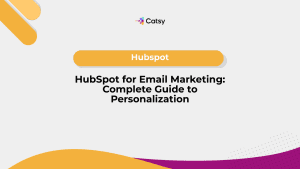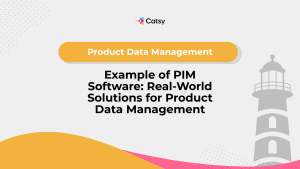Unified PIM and DAM System: The Key to Streamlined Product Management
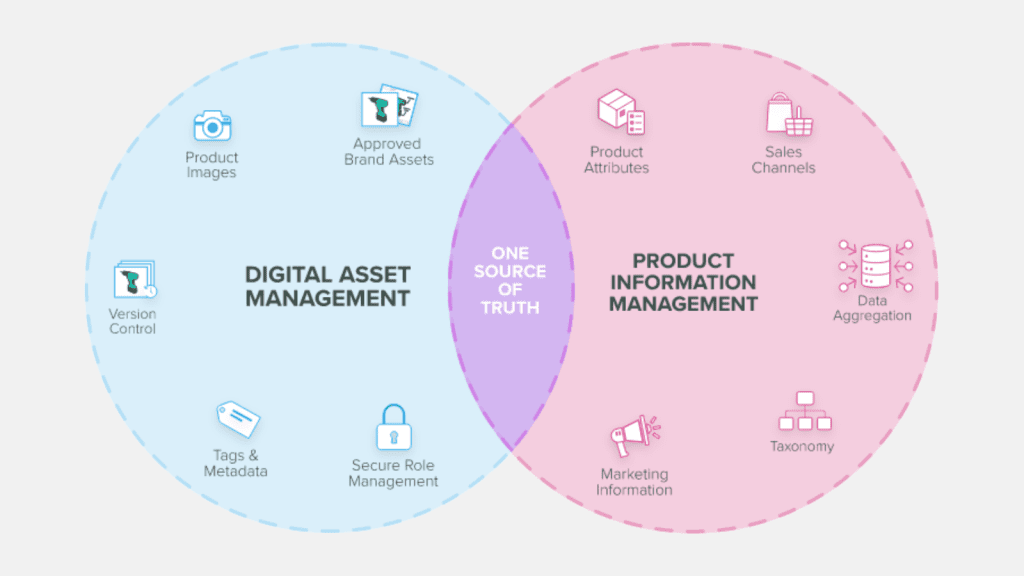
- Disconnected DAM and PIM systems create inefficiencies, increased costs, and inconsistent product information.
- A unified solution improves collaboration, accelerates time-to-market, and enhances the omnichannel experience.
- Investing in a unified DAM and PIM platform saves costs and streamlines operations, driving business growth.
In this Article
Every product manager’s dream is to use the shortest time possible to deliver a product to the market. Then, it is the marketer’s turn to get the product in as many hands as possible. These are only two of the many roles responsible for managing the product and selling to potential customers.
The roles rely on several software solutions to deliver their responsibilities. For instance, they may depend on a product information management (PIM) platform to humanize product details stored in inventory management systems and digital asset management (DAM) software to create a visual story. But here is a catch: these are two different software platforms, which you can acquire from two different vendors, intended to work as one.
So, product managers and marketers find themselves in a state of confusion, much like a chef trying to create a dish, but the kitchen is split into two. In one room, the chef has a pantry overflowing with exotic spices, fresh produce, and delectable cuts of meat. In the other room, there are lots of pots, pans, knives, and every culinary tool imaginable. The only problem? There’s no open space connecting these two rooms. To grab a single ingredient, the chef has to dash through a swinging kitchen door, wasting precious time and disrupting the creative flow.
This disjointed kitchen scenario perfectly reflects the challenges businesses face when managing product information and digital assets in separate systems. The solution? Break down the wall and unify the software platforms. But what does such a solution look like? This post has all the answers.
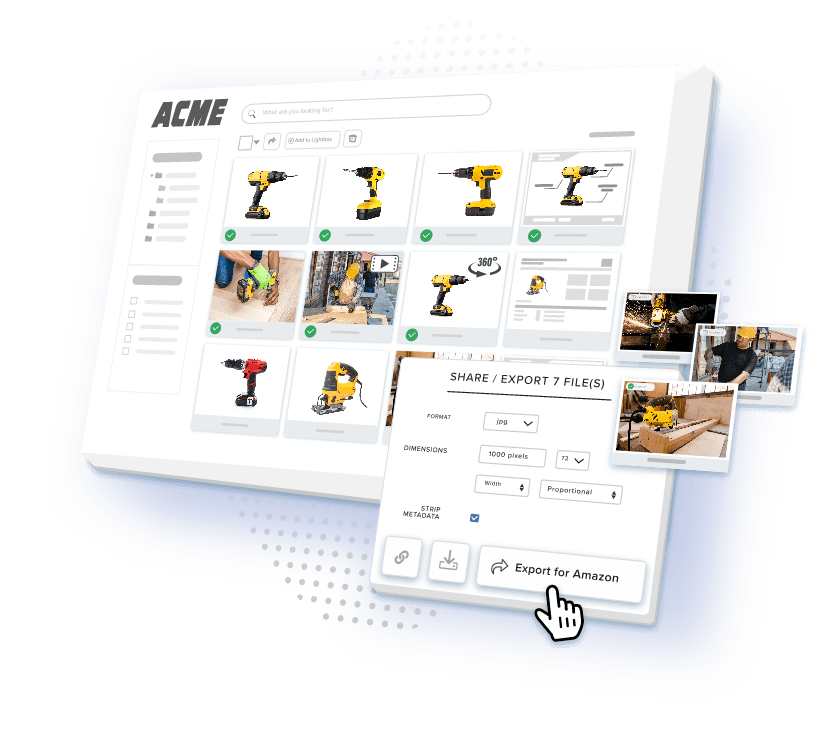
Understanding PIM and DAM System
A unified software solution is the ideal scenario. This means you don’t get it by default; if you do, only a few options are available.
Regarding product data management, the process involves many tools, which keep changing as the life cycle advances.
Product data management begins with inventory management systems (IMS). IMS, like ERP and other databases, are where the bare-bones technical specifications, codes, prices, and logistical data about a product are first entered and tracked. A PIM then ingests the raw data, enriches it, and combines it with enriched digital assets from a DAM to create high-quality product content. The information then journeys from PIM and DAM to detail pages in e-commerce websites or digital catalogs.
As you can see, there are at least three different software platforms through which product data must pass before it is ready for customers. Although you cannot unify the IMS with PIM and DAM, you can integrate the last two and connect them with IMS and upstream platforms like marketplaces and digital catalogs.
Before going any further in the direction of product data management, let’s first understand PIM & DAM and the role they play in the product data management lifecycle.
What is PIM software?
PIM software is the tool you use to make product details in inventory management systems customer-facing. Customer-facing product information is data that an individual browsing the internet can find helpful in deciding to purchase a particular item. This flexibility is crucial for enterprise businesses looking to create a seamless shopping experience by providing product-related information that evolves as customer needs change.
We said earlier that content management begins when a company records prices, codes, technical details, and logistical details about a product in an ERP or organization database. However, these details are barebones and barely legible to an outsider. This characteristic makes inventory management systems fall short of customer-facing needs, especially in digital content where commerce thrives on enriched descriptions and consistent brand messaging.
In other words, inventory management systems store information lacking the richness and detail needed to inform a customer’s choice. The infrastructure focuses on function and not benefits, often using industry jargon that confuses a casual buyer. A PIM bridges the gap between technical data and customer understanding, ensuring that your stack of tools can implement the right balance between functionality and usability.
For instance, suppose you are browsing for a drill, and you happen upon a description drawn directly from the company’s ERP system. Here’s what it might look like:
- Model Number: DRILL-MDX782
- Description: Heavy-duty 18V drill. Includes chuck key and carrying case.
- Price: $199.99
The details are bare, but they serve a purpose: they help internal teams keep track of stock levels, order fulfillment, and various internal processes. However, when presenting product information to customers, they fall woefully short. This is where syndication comes into play, as a PIM platform allows the timely and custom distribution of digital assets across multiple channels, ensuring external platforms receive the most accurate and consistent brand messaging.
A PIM transforms this barebones data into information that customers can understand. It helps you to tell a story rather than merely listing your products’ features. For example, the tool allows you to enrich the description of the drill into something like this:
- Clear and concise description: “Heavy-duty 18V cordless drill ideal for tackling tough materials like concrete and masonry.”
- Benefit-oriented language: “Delivers exceptional power for drilling large holes and driving long screws.”
- Customer-friendly features: “Features a variable speed control for precise drilling in delicate materials and a comfortable, ergonomic grip for extended use.
What about DAM (Digital Asset Management Software)?
A DAM pursues the same goal as a PIM but follows a different path and focuses on a different purpose of product content. Just so we are on the same page, product content is the information (core details like descriptions and technical specifications) and digital content associated with a particular product. The rich media may include visual content like images, icons, graphics, audio, and videos, as well as textual content like user manuals and other documentation.
In other words, a DAM solution consolidates visual and textual content related to a particular product, but that is not the end of it. It allows users to manipulate the assets (resize and adjust display quality), add metadata and alt-text, and edit titles. This asset management system ensures the seamless handling of digital content while also improving the distribution of digital assets across platforms.
Besides asset organization and metadata management, a DAM tool keeps track of the history of digital files. It maintains a record of changes and updates, ensuring that the most current and accurate version of an asset is being used. Whether your content is offline or online, this ensures consistency across corporate channels.
But some of these features are commonplace, with tools like storage drives providing plenty. However, DAM software goes further: it includes access control and permissions features to help maintain asset security. These features are more robust than the basic view-only or edit-and-view features of a platform like Google Drive.
A DAM’s superpower comes to life when it comes to collaboration and distribution of assets. Most DAM solutions provide a brand portal to extend their syndication capabilities. For example, Catsy DAM’s brand portal simplifies asset review processes and ensures compliance with brand guidelines. The portal also ensures seamless asset sharing—partners can self-serve the necessary assets, whether for online or offline use.
Although PIM and DAM’s responsibilities differ, they achieve the same goal: to gather critical product content into a central location, enrich them, and facilitate efficient and seamless distribution. Nonetheless, their effectiveness is blunted if the platforms are not adequately integrated.
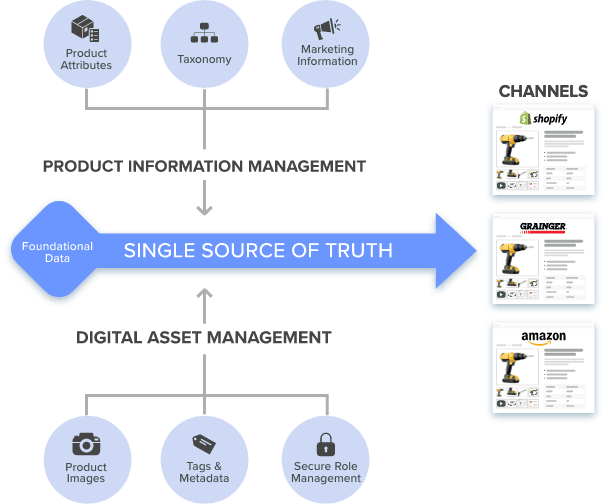
The Problem with Disconnected Systems
PIM and DAM each have robust features that enhance product data management. They help customers make sense of the product details stored in inventory management systems.
However, you can’t extract maximum value from these solutions when they operate in isolation. There is nothing wrong with any of the tools; the problem lies in the nature of disconnected systems, which we will discuss below.
1. Data inconsistencies
Here’s a common scenario: A product manager crafts a detailed description of a new product in the PIM system, highlighting its key features and benefits. On the other hand, the marketing team is working on product images in a DAM. The problem is that since both teams cannot view the product details and the associated photos side-by-side in a single window, they may not showcase the product in a harmonized manner.
For instance, the product’s description might highlight a specific feature, but the accompanying image fails to showcase it. The marketing team wasn’t aware of this particular fact when preparing the image. If this content is syndicated to product detail pages (PDPs) as is, it may do little to convince the customer to purchase.
These inconsistencies not only damage customer experience but also require significant time and effort to rectify. Teams must manually identify and address the discrepancies, often involving lengthy back-and-forth communication between departments. This can slow down the entire product management process, ultimately delaying the time to market for products.
2. Integration challenges
PIM and DAM may handle different aspects of product content, but the tools have a common goal: maintaining a single source of truth for product data. This goal is defeated if users do not have a system view of core product details and digital assets. The solution? Connect the two platforms via APIs and other connectors.
Granted, the integration works. The problem is that the integration process can be messy for the following reasons:
- Resource drain: Integrating two distinct platforms requires time, technical expertise, and ongoing maintenance. This can strain IT resources and delay other critical projects.
- Leaky pipes: Data transfers between systems can be prone to errors. For example, fields might not map correctly, leading to missing or corrupted information. This “leaky pipe” scenario undermines the accuracy of your product data.
- Fragile ecosystem: Integrations often rely on complex configurations and APIs. So, updates or changes within either DAM or PIM can disrupt the connection, requiring constant monitoring and troubleshooting.
3. Operational inefficiencies
Just as a chef wouldn’t want their kitchen split into separate rooms, managing product information and digital assets in two different systems creates operational inefficiencies. Here’s why:
- Juggling acts and context switching: Imagine product managers having to jump between a PIM system for descriptions and a DAM system for images. This constant context-switching disrupts the workflow and slows the creation and updating of product details. It’s like trying to cook a meal while constantly sprinting between two kitchens – inefficient and prone to errors.
- Duplication of effort: Disconnected systems often lead to duplicate data entry. For instance, a product name might be entered in the PIM and again when uploading an image in the DAM. This duplication wastes valuable time and resources.
- Silos of information: With data residing in separate systems, gaining a holistic view of a product becomes challenging. This hinders collaboration and leads to missed opportunities to optimize product launches or marketing campaigns.
4. Increased costs
Beyond the operational inefficiencies, disconnected DAM and PIM systems create a direct financial burden for businesses. Some of these cost factors include:
- Double the licensing fees: Naturally, acquiring and maintaining two separate software licenses is more costly than investing in a unified solution. This can be a significant expense, especially for smaller businesses with tighter budgets.
- Hidden costs of complexity: Integrations, as we’ve discussed, cost resources and time. Maintaining the connection, troubleshooting errors, and keeping everything up to date add to the ongoing expenses.
- The price of wasted time: When employees spend time manually transferring data, searching across platforms, and dealing with inconsistencies, that time is not spent on value-driving tasks. This inefficiency and missed opportunity translate to lost revenue.
- Training and support: With two systems comes the need for double the onboarding, training, and support personnel. This again contributes to an increased overall cost for managing product information.
Investing in a unified DAM & PIM system is not just about convenience; it’s a sound financial decision. Like the chef who finally remodels their kitchen for better efficiency, a unified solution brings numerous benefits.
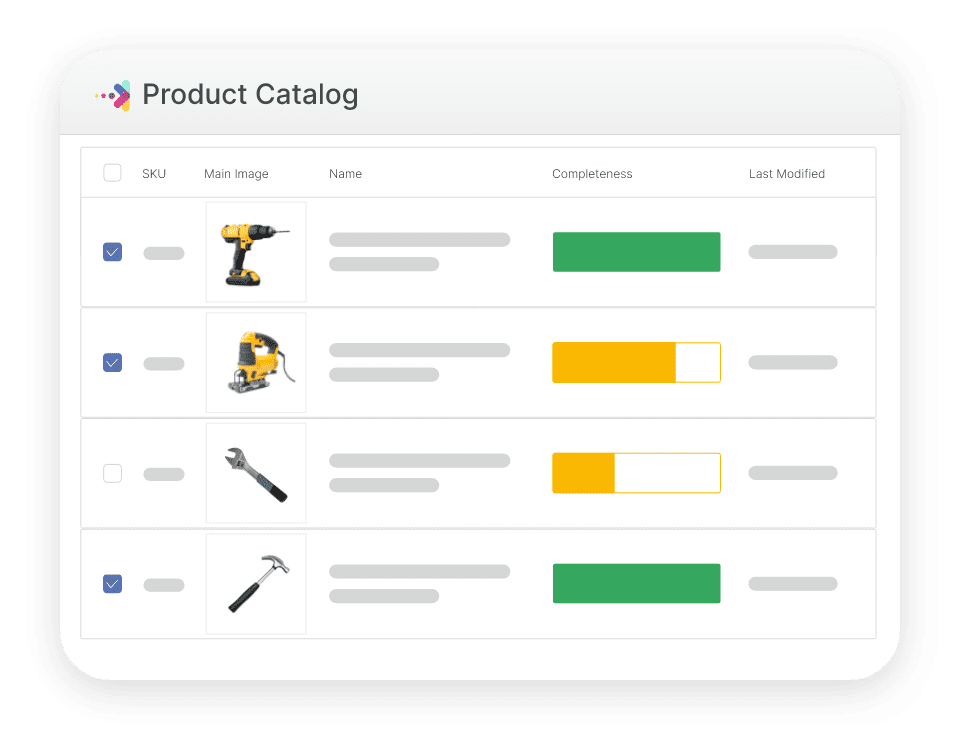
The Benefits of a Unified PIM DAM Solution
Undoubtedly, a unified PIM and DAM platform is transformational, not only in terms of operational efficiency but also in financial terms. But what really is a unified PIM and DAM?
PIM and DAM are two data management solutions that can operate independently. However, as we have established, they pursue a common goal and are often connected to collate the product content before it is syndicated to channels.
A unified PIM and DAM is a configuration where the two platforms exist as one solution. Catsy is an excellent example of such a system. PIM and DAM exist side-by-side as tabs within a single platform. This means you have core product details and digital assets closer than ever before. Even better, Catsy allows you to view the PIM side in one split view and the DAM side in the other. This is the essence of a unified software solution and provides many benefits.
1. Unified DAM PIM System provide improved collaboration
In a unified system, all teams work from a single, shared platform. This has a transformative effect on collaboration.
For instance, designers can access the most up-to-date product specifications by clicking the “PIM” tab. Similarly, marketers can easily view approved visuals corresponding to enriched product descriptions. All this happens without switching to a different browser tab.
A unified platform delivers a seamless workflow in place of fragmented systems. The broad view of product content expedites processes like asset approval because it is easy to see how everything aligns with brand guidelines.
The brand portal allows users to comment, annotate, and self-serve assets directly within the platform. These assets can easily be mapped to related descriptions, meaning users get the best quality product content with a few button clicks.
2. Unified DAM PIM provide faster time-to-market
Beating everyone to market is the product manager’s dream. That is why, together with marketers, they work so hard to convince the top management to acquire tools like PIM and DAM. But, as we’ve seen, these systems are underpowered when not adequately integrated.
A unified DAM & PIM solution enables you to kill two birds with one stone. You can quickly find assets, make changes, and simultaneously tweak product descriptions. These changes are then automatically reflected across all connected channels. This streamlined process reduces unnecessary delays, helping you bring products to market faster and seize opportunities before your competitors.
3. Unified DAM PIM provide enhanced omnichannel experience
The ideal unified DAM & PIM solution should allow you to syndicate complete (enriched product details and edited digital assets) and current product content simultaneously to channels. This prevents you from having to do the synchronization separately, once in a PIM and once in a DAM.
This is precisely the functionality you get with Catsy’s unified PIM and DAM platform. The platform goes a step ahead to provide users with channel templates to expedite the adaptation and distribution of product content across all supported touchpoints. This capability makes Catsy a robust backbone of an authentic omnichannel experience.
With the system powering the backend for PDPs and digital catalogs, your customers will encounter the same compelling product story, regardless of where they interact with your brand. Imagine being able to repurpose high-quality product images for Amazon quickly, adjust descriptions to fit marketplace requirements, and translate product details for global audiences – all from within a single platform. That’s the power of a unified system; it eliminates the need to tailor content manually, allowing you to deliver consistent and engaging customer experience across all channels.
4. Unified DAM PIM provide cost savings
Successful businesses are those that minimize cost centers without impacting the effectiveness of their operations. A unified PIM and DAM solution is an excellent strategy for achieving such a goal.
As previously mentioned, maintaining separate DAM and PIM systems leads to increased acquisition, implementation, training, and ongoing maintenance expenses.
A unified solution allows businesses to eliminate these redundant costs and allocate resources more effectively. The streamlined acquisition process and reduced need for training and support results in lower upfront expenses. Additionally, the simplified implementation and maintenance of a single platform translates to substantial long-term savings.
Brands can reinvest these cost savings into other strategic initiatives, such as product development, marketing campaigns, or customer experience enhancements, ultimately driving business growth and improving overall performance.

How to Persuade the Management to Invest in a Unified DAM & PIM Solution
You might be convinced of the benefits of a unified DAM and PIM solution, but how can you persuade the management to share your vision and approve the investment? Here are some tips to help you make a strong case for a unified platform.
Show them the numbers.
Use data and metrics to demonstrate the current state of your product information and digital asset management processes. Highlight the pain points, inefficiencies, and risks of having separate systems. Then, estimate a unified solution’s potential savings and returns based on industry benchmarks, case studies, or pilot projects. Show them the expected ROI and break-even point of the investment.
Align with their goals.
Understand the strategic objectives and priorities of the management and show them how a unified DAM and PIM solution can help them achieve them. For example, if they want to expand into new markets, emphasize how a unified platform can enable faster and easier localization of product content and assets. If they want to improve customer satisfaction and retention, highlight how a unified platform can ensure consistent and accurate product information across all channels and touchpoints.
Address their concerns.
Anticipate the possible objections and challenges that management might raise and prepare to counter them with facts and evidence. For example, if they are worried about the disruption and complexity of migrating from separate systems to a unified platform, explain how the vendor can provide a smooth transition plan and support. If they are concerned about the security and compliance of the unified platform, assure them that the vendor can meet the highest standards and best practices of data protection and governance.
Involve them in the decision-making process.
Rather than presenting a finalized proposal, invite the management to participate in evaluating and selecting the unified DAM and PIM solution. Engage them in demos, workshops, and consultations with the vendor and solicit their feedback and input. By involving them in the process, you can build trust and rapport, address any doubts or questions, and increase their buy-in and commitment to the investment.
Conclusion
The initial cost of a unified DAM and PIM solution might seem like a significant investment compared to maintaining separate systems. However, a closer look reveals a compelling truth—it’s a strategic decision with long-term benefits.
Think of it this way: a well-equipped, efficient kitchen doesn’t come with separate bills for the stove, refrigerator, and countertop. A unified DAM & PIM is the complete culinary toolkit for your product information and digital assets.
The system eliminates the need for multiple software licenses and integrations and the hidden costs of wasted time and duplicated effort, delivering substantial cost savings. Furthermore, it fosters collaboration, accelerates time-to-market, and empowers you to provide a seamless omnichannel customer experience.
A unified DAM and PIM platform is an investment in streamlined operations and maximized efficiency. It empowers teams to work smarter, not harder, ultimately driving business growth and success.
Digital Asset Management (DAM) systems focus on storing, organizing, and managing digital assets like images, videos, and documents. Product Information Management (PIM) systems, on the other hand, are designed to centralize, manage, and distribute product data and information. While both systems deal with different aspects of product data, a unified DAM and PIM solution enables businesses to manage digital assets and product information on a single platform.
Absolutely! While some set-up and migration efforts may be involved, the benefits often far outweigh the initial investment. By streamlining workflows, eliminating inconsistencies, and improving collaboration, a unified solution saves time and reduces errors in the long run. Consider the hidden costs of your current setup – time wasted on manual tasks, frustration from data discrepancies, and missed opportunities due to delays. These factors contribute to the overall financial and operational impact of switching to a unified platform.
A unified DAM and PIM solution enables businesses to quickly adapt and deploy product information and digital assets across various channels, such as websites, marketplaces, social media, and print catalogs. By maintaining consistency and accuracy in product information and visuals across all touchpoints, businesses can build customer trust and credibility, ultimately driving conversions and loyalty. The ability to quickly update and distribute product information and assets across channels allows companies to respond more effectively to changing market trends and customer preferences.
While any transition to a new system may involve some adjustment, the benefits of a unified DAM & PIM solution often outweigh any temporary disruptions. Most robust unified solutions, like Catsy, are designed with user experience in mind, offering intuitive interfaces and robust customization options to align with your existing workflows. Additionally, many providers offer comprehensive training and support to ensure a smooth transition for your team. Ultimately, the streamlined workflows and efficiencies from adopting a unified solution far outweigh any short-term disruptions.
Focus on the return on investment (ROI). Calculate the current costs of wasted time, inefficient processes, and inconsistencies. Contrast this with a unified solution’s potential savings and revenue growth. Most importantly, highlight the benefits like faster time-to-market and a seamless customer experience – these often directly correlate to increased sales.

